Early Cretaceous Granitoids Magmatism in the Nagqu Area, Northern Tibet: Constraints on the Timing of the Lhasa–Qiangtang Collision
Abstract
:1. Introduction
2. Geological Background
3. Petrography
4. Analytical Methods
4.1. Zircon U–Pb and In Situ Lu–Hf Isotopic Analyses
4.2. Whole-Rock Major and Trace Element Analyses
4.3. Whole-Rock Sr–Nd Isotopic Analyses
5. Results
5.1. Zircon U–Pb Ages and Lu–Hf Isotopic Compositions
5.1.1. YLSZ–9 (Quartz Diorite–Porphyrite)
5.1.2. YLSZ–10 (Quartz Diorite–Porphyrite)
5.1.3. YLSS–4 (Granophyre)
5.1.4. BCD–1 (Granite)
5.1.5. BCD–6 (Granite)
5.1.6. BCN–1 (Granite)
5.1.7. BCN–2 (Granite)
5.1.8. TL–3 (Granite)
5.2. Whole-Rock Geochemical Compositions
5.2.1. YLSZ Quartz Diorite–Porphyrite
5.2.2. YLSS Granophyre
5.2.3. Amdo Granite
5.3. Whole-Rock Sr–Nd Isotopic Compositions
6. Discussion
6.1. Zircon U–Pb Ages and Implications
6.2. Petrogenesis
6.2.1. YLSZ Quartz Diorite–Porphyrite
6.2.2. YLSS Granophyre
6.2.3. BCD, BCN and TL Granites
BCD I-Type Granite
BCN and TL Untypical A-Type Granites
6.3. Tectonic Setting and Geodynamic Implications
7. Conclusions
- The Yilashan and Amdo granitoid samples were formed at ~121–110 Ma related to the collision between the Lhasa and southern Qiangtang (–Amdo) terranes. The BNTO was closed during this period in the study area.
- The Yilashan S-type granophyres were derived from partial melting of a Paleoproterozoic metagraywacke source in the lower crust. The Yilashan quartz diorite–porphyrites and the Amdo I-type granites were mainly originated from partial melting of Paleo–Mesoproterozoic lower crustal mafic rocks involved with a small amount of components derived from the Amdo orthogneisses and mantle-derived magmas. The Amdo A-type granites were mainly derived from a Paleo–Mesoproterozoic (dominated by Paleoproterozoic) source composed of metabasaltic rocks along with the insignificant input of mantle-derived melts. A Precambrian “hidden” crust likely existed beneath the northern Lhasa and Amdo blocks.
- The underplating of mantle-derived melts related to asthenospheric upwelling not only provided sufficient heat for partial melting of crustal sources at various levels but also led to crustal-derived melts to mix with mantle-derived materials (the YLSZ quartz diorite–porphyrite and the Amdo granites).
- The Yilashan ophiolite was intruded by the Early Cretaceous (~112–108 Ma) granophyric and quartz diorite–porphyritic intrusions prior to its final tectonic emplacement into the surrounding Jurassic strata.
Supplementary Materials
Author Contributions
Funding
Data Availability Statement
Acknowledgments
Conflicts of Interest
References
- Pitcher, W.S. The Nature and Origin of Granite; Springer: Dordrecht, The Netherlands, 1997; Volume 14, pp. 288–294. [Google Scholar]
- Rudnick, R.; Gao, S. The role of lower crustal recycling in continent formation. Geochim. Et Cosmochim. Acta 2003, 67, 43. [Google Scholar]
- Gao, P.; Zheng, Y.F.; Zhao, Z.F. Experimental melts from crustal rocks: A lithochemical constraint on granite petrogenesis. Lithos 2016, 266–267, 133–157. [Google Scholar] [CrossRef]
- Hopkinson, T.N.; Harris, N.B.W.; Warren, C.J.; Spencer, C.J.; Roberts, N.M.W.; Horstwood, M.S.A.; Parrish, R.R. EIMF. The identification and significance of pure sediment–derived granites. Earth Planet Sci. Lett. 2017, 467, 57–63. [Google Scholar] [CrossRef] [Green Version]
- Xu, C.; Yuan, Y.J.; Xiao, Y.; Guo, F.; Xia, B.; Lu, Y. Geochemistry and Geochronology of the Cenozoic Zhalaga Granitoids of the Yulong Alkali-rich Porphyry Belt in Eastern Tibet (Xizang), SW China: Petrogenesis and Tectonic Implications. Acta Geol. Sin-Engl. 2020, 94, 2077–2090. [Google Scholar]
- Yuan, Y.J.; Zhong, Y.; Guo, F.; Xia, B.; Zhang, Y.Q. Geochemical and geochronological constraints on the genesis of Pliocene post–collisional granite porphyry and shoshonite in Quanshuigou, western Kunlun Mountains, NW Qinghai–Tibet Plateau. Int. Geol. Rev. 2022, 64, 275–296. [Google Scholar] [CrossRef]
- Zhu, D.C.; Mo, X.X.; Niu, Y.; Zhao, Z.D.; Wang, L.Q.; Liu, Y.S.; Wu, F.Y. Geochemical investigation of Early Cretaceous igneous rocks along an east–west traverse throughout the central Lhasa Terrane, Tibet. Chem. Geol. 2009, 268, 298–312. [Google Scholar] [CrossRef]
- Zhu, D.C.; Zhao, Z.D.; Niu, Y.; Mo, X.X.; Chung, S.L.; Hou, Z.Q. The Lhasa Terrane: Record of a microcontinent and its histories of drift and growth. Earth Planet Sci. Lett. 2011, 301, 241–255. [Google Scholar] [CrossRef]
- Zhu, D.C.; Zhao, Z.D.; Niu, Y.L.; Dilek, Y.; Hou, Z.Q.; Mo, X.X. The origin and pre–Cenozoic evolution of the Tibetan Plateau. Gondwana Res. 2013, 23, 1430–1455. [Google Scholar] [CrossRef]
- Ji, W.Q.; Wu, F.Y.; Chung, S.L.; Li, J.X.; Liu, C.Z. Zircon U–Pb chronology and Hf isotopic constraints on the petrogenesis of Gangdese batholiths, southern Tibet. Chem. Geol. 2009, 262, 229–245. [Google Scholar] [CrossRef]
- Liu, D.L.; Shi, R.D.; Ding, L.; Huang, Q.S.; Zhang, X.R.; Yue, Y.H.; Zhang, L.Y. Zircon U–Pb age and Hf isotopic compositions of Mesozoic granitoids in southern Qiangtang, Tibet: Implications for the subduction of the Bangong–Nujiang Tethyan ocean. Gondwana Res. 2017, 41, 157–172. [Google Scholar] [CrossRef]
- Xu, R.H.; Schärer, U.; Allègre, C.J. Magmatism and metamorphism in the Lhasa block (Tibet): A chronological study. J. Geol. 1985, 93, 41–57. [Google Scholar] [CrossRef]
- Ma, A.; Hu, X.M.; Garzanti, E.; Han, Z.; Lai, W. Sedimentary and tectonic evolution of the southern Qiangtang basin: Implications for the Lhasa–Qiangtang collision timing: Mesozoic geology of central Tibet. J. Geophys. Res. Solid Earth 2017, 122, 4790–4813. [Google Scholar] [CrossRef]
- Ratschbacher, L.; Frisch, W.; Liu, G.; Chen, C. Distributed deformation in southern and western Tibet during and after the India–Asia collision. J. Geophys. Res. Solid Earth 1994, 99, 19917–19945. [Google Scholar] [CrossRef]
- Kapp, P.; DeCelles, P.G.; Gehrels, G.E.; Heizler, M.; Ding, L. Geological records of the Lhasa–Qiangtang and Indo–Asian collisions in the Nima area of central Tibet. Geol. Soc. Am. Bull. 2007, 119, 917–933. [Google Scholar] [CrossRef]
- Raterman, N.S.; Robinson, A.C.; Cowgill, E.S. Structure and detrital zircon geochronology of the Domar fold–thrust belt: Evidence of pre–Cenozoic crustal thickening of the western Tibetan Plateau. Spec. Pap. Geol. Soc. of Am. 2014, 507, 89–114. [Google Scholar]
- Chen, S.S.; Shi, R.D.; Zou, H.B.; Huang, Q.S.; Liu, D.L.; Gong, X.H.; Yi, G.D.; Wu, K. Late Triassic Island–arc–back–arc basin development along the Bangong–Nujiang suture zone (central Tibet): Geological, geochemical and chronological evidence from volcanic rocks. Lithos 2015, 230, 30–45. [Google Scholar] [CrossRef]
- Zhu, D.C.; Li, S.M.; Cawood, A.; Wang, Q.; Zhao, Z.D.; Liu, S.A.; Wang, L.Q. Assembly of the Lhasa and Qiangtang terranes in central Tibet by divergent double subduction. Lithos 2016, 245, 7–17. [Google Scholar] [CrossRef] [Green Version]
- Zhu, Z.C.; Zhai, Q.G.; Hu, P.Y.; Tang, Y.; Wang, H.T.; Wang, W.; Hao, W.; Huang, Z.Q. Timing of the Lhasa–Qiangtang Collision: Constraints from the sedimentary records of the Duoni Formation from the middle segment of the Bangong–Nujiang suture zone. Acta Sediment. Sinica 2020, 38, 712–726, (In Chinese with English Abstract). [Google Scholar]
- Bian, W.W.; Yang, T.S.; Ma, Y.M.; Jin, J.J.; Gao, F.; Zhang, S.H.; Wu, H.C.; Li, H.Y. New Early Cretaceous palaeomagnetic and geochronological results from the far western Lhasa terrane: Contributions to the Lhasa–Qiangtang collision. Sci. Rep. UK 2017, 7, 16216. [Google Scholar] [CrossRef] [Green Version]
- Fan, J.J.; Li, C.; Liu, J.H.; Wang, M.; Liu, Y.M.; Xie, C.M. The Middle Triassic evolution of the Bangong–Nujiang Tethyan Ocean: Evidence from analyses of OIB–type basalts and OIB–derived phonolites in northern Tibet. Int. J. Earth Sci. 2017, 107, 1755–1775. [Google Scholar] [CrossRef]
- Lai, W.; Hu, X.M.; Garzanti, E.; Xu, Y.W.; Ma, A.L.; Li, W. Early Cretaceous sedimentary evolution of the northern Lhasa terrane and the timing of initial Lhasa–Qiangtang collision. Gondwana Res. 2019, 73, 136–152. [Google Scholar] [CrossRef]
- Wang, W.; Wang, M.; Zhai, Q.G.; Xie, C.M.; Hu, P.Y.; Li, C.; Liu, J.H.; Luo, A.B. Transition from oceanic subduction to continental collision recorded in the Bangong–Nujiang suture zone: Insights from Early Cretaceous magmatic rocks in the north–central Tibet. Gondwana Res. 2020, 78, 77–91. [Google Scholar] [CrossRef]
- Wang, S.; Yang, T.S.; Gao, F.; Bian, W.W.; Jin, J.J.; Peng, W.X.; Jiao, X.W.; Ma, J.H.; Zhang, S.H.; Wu, H.C.; et al. Paleomagnetic and geochronological results of the Risong formation in the western Lhasa terrane: Insights into the Lhasa-Qiangtang collision and stratal age. Palaeogeogr. Palaeocl. 2022, 586, 110778. [Google Scholar] [CrossRef]
- Bao, S.; Xiao, X.C.; Su, L.; Wang, J. Geochemical characteristics and isotopic dating for the Dongcuo ophiolite, Tibet Plateau. Sci. China Earth Sci. 2007, 50, 660–671. [Google Scholar] [CrossRef]
- Zhang, Y.X.; Li, Z.W.; Yang, W.G.; Zhu, L.D.; Jin, X.; Zhou, X.Y.; Tao, G.; Zhang, K.J. Late Jurassic–Early Cretaceous episodic development of the Bangong Meso–Tethyan subduction: Evidence from elemental and Sr–Nd isotopic geochemistry of arc magmatic rocks, Gaize region, central Tibet, China. J. Asian Earth Sci. 2017, 135, 212–242. [Google Scholar] [CrossRef]
- Liu, W.L.; Huang, Q.T.; Gu, M.; Zhong, Y.; Zhou, R.J.; Gu, X.D.; Zheng, H.; Liu, J.N.; Lu, X.X.; Xia, B. Origin and tectonic implications of the Shiquanhe high–Mg andesite, western Bangong suture, Tibet. Gondwana Res. 2018, 60, 1–14. [Google Scholar] [CrossRef]
- Cao, Y.; Sun, Z.; Li, H.; Ye, X.; Yang, Z. Paleomagnetism and U-Pb geochronology of early Cretaceous volcanic rocks from the Qiangtang block, tibetan plateau: Implications for the Qiangtang-Lhasa collision. Tectonophysics 2020, 789, 228500. [Google Scholar] [CrossRef]
- Fan, J.J.; Niu, Y.; Liu, Y.M.; Hao, Y.J. Timing of closure of the Meso-Tethys ocean: Constraints from remnants of a 141–135 ocean island within the bangong-nujiang suture zone, Tibetan Plateau. Geol. Soc. Am. Bull. 2021, 133, 1875–1889. [Google Scholar] [CrossRef]
- Shuai, X.; Li, S.M.; Zhu, D.C.; Wang, Q.; Zhao, Z. Tetrad effect of rare earth elements caused by fractional crystallization in high-silica granites: An example from central tibet. Lithos 2021, 384–385, 105968. [Google Scholar] [CrossRef]
- Yin, A.; Harrison, T.M. Geologic evolution of the Himalayan–Tibetan orogen. Annu. Rev. Earth Planet. Sci. 2000, 28, 211–280. [Google Scholar] [CrossRef] [Green Version]
- Fan, J.J.; Li, C.; Wang, M.; Xie, C.M. Reconstructing in space and time the closure of the middle and western segments of the Bangong–Nujiang Tethyan Ocean in the Tibetan Plateau. Int. J. Earth Sci. 2018, 107, 231–249. [Google Scholar] [CrossRef]
- Xizang Geological Survey Institute. The regional geological survey of Nagqu Sheet. scale 1:500,000, 1 sheet. 2005; unpublished. (In Chinese) [Google Scholar]
- China University of Geosciences (Beijing). The regional geological survey of 1: 250,000 Amdo Sheet. 2005; unpublished. (In Chinese) [Google Scholar]
- Zhang, Z.M.; Dong, X.; Liu, F.; Lin, Y.H.; Yan, R.; Santosh, M. Tectonic evolution of the Amdo terrane, central Tibet: Petrochemistry and zircon U–Pb geochronology. J. Geol. 2012, 120, 431–451. [Google Scholar] [CrossRef]
- Harris, N.B.W.; Holland, T.J.B.; Tindle, A.G. Metamorphic rocks of the 1985 Tibet Geotraverse, Lhasa to Golmud. Philos. Trans. R. Soc. Lond. 1988, 327, 203–213. [Google Scholar]
- Guynn, J.; Kapp, P.; Gehrels, G.E.; Ding, L. U–Pb geochronology of basement rocks in central Tibet and paleogeographic. J. Asian Earth Sci. 2012, 43, 23–50. [Google Scholar] [CrossRef]
- Guynn, J.; Tropper, P.; Kapp, P.; Gehrels, G.E. Metamorphism of the Amdo metamorphic complex, Tibet: Implications for the Jurassic tectonic evolution of the Bangong suture zone. J. Metamorph. Geol. 2013, 31, 705–727. [Google Scholar] [CrossRef]
- Lu, L.; Wu, Z.H.; Zhao, Z.; Hu, D.G.; Ye, P.S. Zircon SHRIMP U–Pb dating, geochemical characteristics and tectonic significance of granitic gneisses in Amdo, Tibet. J. Earth Sci. China 2014, 25, 473–485. [Google Scholar] [CrossRef]
- Lu, L.; Qian, C.; Zhao, Z.; Wu, Z.; Liu, Y.; Zhou, L.; Wang, Y. Geochronological evidence of Ordovician and Jurassic magmatic events in Nyainrong microcontinent, Tibet. Earth Sci. 2018, 43, 1110–1124, (In Chinese with English Abstract). [Google Scholar]
- Zhang, X.R.; Shi, R.D.; Huang, Q.S.; Liu, D.L.; Gong, X.H.; Chen, S.S.; Wu, K.; Yi, G.D.; Sun, Y.L.; Ding, L. Early Jurassic high–pressure metamorphism of the Amdo terrane, Tibet: Constraints from zircon U–Pb geochronology of mafic granulites. Gondwana Res. 2014, 26, 975–985. [Google Scholar] [CrossRef]
- Dai, J.G.; Wang, C.S.; Hourigan, J.K.; Santosh, M. Insights into the early Tibetan Plateau from (U–Th)/He thermochronology. J. Geol. Soc. Lond. 2013, 170, 917–927. [Google Scholar] [CrossRef]
- Huang, Q.S.; Shi, R.D.; Liu, D.L.; Zhang, X.R.; Fan, S.Q.; Ding, L. Os isotopic evidence for a carbonaceous chondritic mantle source for the Nagqu ophiolite from Tibet and its implications. Chin. Sci. Bull. 2013, 58, 92–98, (In Chinese with English Abstract). [Google Scholar] [CrossRef] [Green Version]
- Yin, Z.X.; Yuan, Y.J.; LÜ, B.F.; Cai, Z.R.; Zheng, H.; Huang, Q.T.; Xia, B.; Zhong, Y.; Xia, Z.Y.; Shi, X.L.; et al. Zircon U–Pb Geochronology and Hf Isotopic Constraints on Petrogenesis of Plagiogranite from the Cuomuqu Ophiolite, Bangong Lake Area, North Tibet. Acta Geol. Sin-Engl. 2015, 89, 418–440. [Google Scholar]
- Zhong, Y.; Hu, X.C.; Liu, W.L.; Xia, B.; Zhang, X.; Huang, W.; Fu, Y.B.; Wang, Y.G. Age and nature of the Jurassic–Early Cretaceous mafic and ultramafic rocks from the Yilashan area, Bangong–Nujiang suture zone, central Tibet: Implications for petrogenesis and tectonic Evolution. Int. Geol. Rev. 2017, 60, 1244–1266. [Google Scholar] [CrossRef]
- Zhang, R. The Feature and Tectonic Setting of Chromitite from the Yilashan Ophiolite in Middle Section of Bangong–Nujiang Suture Zone, Tibet. Master’s Thesis, Chinese Academy of Geological Sciences, Beijing, China, 2020; pp. 1–92, (In Chinese with English Abstract). [Google Scholar]
- Garzanti, E.; Le Fort, P.; Sciunnach, D. First report of Lower Permian basalts in South Tibet: Tholeiitic magmatism during break–up and incipient opening of Neotethys. J. Asian Earth Sci. 1999, 17, 533–546. [Google Scholar] [CrossRef]
- Stampfli, G.M. Tethyan oceans. Geol. Soc. Lond. Spec. Publ. 2000, 173, 1–23. [Google Scholar] [CrossRef]
- Zhang, K.J.; Cai, J.X.; Zhang, Y.X.; Zhao, T.P. Eclogites from central Qiangtang, northern Tibet (China) and tectonic implications. Earth Planet Sci. Lett. 2006, 245, 722–729. [Google Scholar] [CrossRef]
- Schneider, W.; Mattern, F.; Wang, P.; Li, C. Tectonic and sedimentary basin evolution of the eastern Bangong–Nujiang zone (Tibet): A Reading cycle. Int. J. Earth Sci. 2003, 92, 228–254. [Google Scholar] [CrossRef]
- Pullen, A.; Kapp, P.; Gehrels, G.E.; Ding, L.; Zhang, Q. Metamorphic rocks in central Tibet: Lateral variations and implications for crustal structure. Geol. Soc. Am. Bull. 2011, 123, 585–600. [Google Scholar] [CrossRef]
- Zhang, K.J.; Zhang, Y.X.; Tang, X.C.; Xia, B. Late Mesozoic tectonic evolution and growth of the Tibetan plateau prior to the Indo–Asian collision. Earth Sci. Rev. 2012, 14, 236–249. [Google Scholar] [CrossRef]
- Hao, L.L.; Wang, Q.; Wyman, D.A.; Quan, O.; Dan, W.; Jiang, Z.Q.; Wu, F.Y.; Yang, J.S.; Long, X.P.; Li, J. Underplating of basaltic magmas and crustal growth in a continental arc: Evidence from Late Mesozoic intermediate–felsic intrusive rocks in southern Qiangtang, central Tibet. Lithos 2015, 245, 223–242. [Google Scholar] [CrossRef]
- Hou, Z.Q.; Duan, L.F.; Lu, Y.J.; Zheng, Y.C.; Zhu, D.C.; Yang, Z.M.; Yang, Z.S.; Wang, B.D.; Pei, Y.R.; Zhao, Z.D.; et al. Lithospheric architecture of the Lhasa terrane and its control on ore deposits in the Himalayan–Tibetan orogen. Econ. Geol. 2015, 110, 1541–1575. [Google Scholar] [CrossRef]
- Liu, D.L.; Shi, R.D.; Ding, L.; Zou, H.B. Late Cretaceous transition from subduction to collision along the Bangong–Nujiang Tethys: New volcanic constraints from central Tibet. Lithos 2018, 296–299, 452–470. [Google Scholar] [CrossRef]
- Sui, Q.L.; Wang, Q.; Zhu, D.C.; Zhao, Z.D.; Chen, Y.; Santosh, M.; Hu, C.Z.; Yuan, H.L.; Mo, X.X. Compositional diversity of ca. 110 Ma magmatism in the northern Lhasa Terrane, Tibet: Implications for the magmatic origin and crustal growth in a continent–continent collision zone. Lithos 2013, 168–169, 144–159. [Google Scholar] [CrossRef]
- Xiao, X.C.; Li, Y.D. Tectonic and Evolution and Uplift of Qinghai–Xizang (Tibet) Plateau; Guangdong Science and Technology Press: Guangzhou, China, 2000; pp. 1–313, (In Chinese with English abstract). [Google Scholar]
- Zhong, Y.; Liu, W.L.; Xia, B.; Liu, J.N.; Guan, Y.; Huang, W.; Sun, X.M. Geochemistry and geochronology of the Mesozoic Lanong ophiolitic mélange, northern Tibet: Implications for petrogenesis and tectonic evolution. Lithos 2017, 292–293, 111–131. [Google Scholar] [CrossRef]
- Wang, B.D.; Wang, L.Q.; Chung, S.L.; Chen, J.L.; Yin, F.G.; Liu, H.; Li, X.B.; Chen, L.K. Evolution of the Bangong–Nujiang Tethyan ocean: Insights from the geochronology and geochemistry of mafic rocks within ophiolites. Lithos 2016, 245, 18–33. [Google Scholar] [CrossRef]
- Tang, Y.; Zhai, Q.G.; Hu, P.Y.; Xiao, X.C.; Wang, H.T. Petrology, geochemistry and geochronology of the Zhongcang ophiolite, northern Tibet: Implications for the evolution of the Bangong–Nujiang Ocean. Geosci. Front. 2018, 9, 1369–1381. [Google Scholar] [CrossRef]
- Pan, G.T.; Wang, L.Q.; Li, R.S.; Yuan, S.H.; Ji, W.H.; Yin, F.G.; Zhang, W.P.; Wang, B.D. Tectonic evolution of the Qinghai–Tibet Plateau. J. Asian Earth Sci. 2012, 53, 3–14. [Google Scholar] [CrossRef]
- Coward, M.P.; Kidd, W.F.; Yun, P.; Shackleton, R.M.; Zhang, H. The structure of the 1985 Tibet Geotraverse, Lhasa to Golmud. Philos. Trans. R. Soc. Lond. 1988, 327, 307–336. [Google Scholar]
- Zhang, Z.M.; Dong, X.; Santosh, M.; Zhao, G.C. Metamorphism and tectonic evolution of the Lhasa terrane, Central Tibet. Gondwana Res. 2014, 25, 170–189. [Google Scholar] [CrossRef]
- Shi, R.D.; Griffin, W.L.; O’Reilly, S.Y.; Huang, Q.S.; Zhang, X.R.; Liu, D.L.; Zhi, X.C.; Xia, Q.X.; Ding, L. Melt/mantle mixing produces podiform chromite deposits in ophiolites: Implications of Re–Os systematics in the Dongqiao Neo–Tethyan ophiolite, northern Tibet. Gondwana Res. 2012, 21, 194–206. [Google Scholar] [CrossRef]
- Liu, Y.; Gao, S.; Hu, Z.; Gao, C.; Zong, K.; Wang, D. Continental and oceanic crust recycling–induced melt–peridotite interactions in the Trans–North China Orogen: U–Pb dating, Hf isotopes and trace elements in zircons from mantle xenoliths. J. Petrol. 2010, 51, 537–571. [Google Scholar] [CrossRef]
- Ludwing, K.R. Isoplot: A Geochronological Toolkit for Microsoft Excel; Berkeley Geochronology Center Special Publication: Berkeley, CA, USA, 2003; pp. 1–70. [Google Scholar]
- Scherer, E.; Münker, C.; Mezger, K. Calibration of the Lutetium–Hafnium Clock. Science 2001, 293, 683–687. [Google Scholar] [CrossRef] [PubMed]
- Blichert, T.J.; Albarede, F. The Lu–Hf geochemistry of the chondrites and the evolution of the mantle–crust system. Earth Planet Sci. Lett. 1997, 148, 243–258. [Google Scholar] [CrossRef]
- Griffin, W.L.; Belousova, E.A.; Shee, S.R.; Pearson, N.J.; O’Reilly, S.Y. Archean crustal evolution in the northern Yilgarn Craton: U–Pb and Hf–isotope evidence from detrital zircons. Precambrian Res. 2004, 131, 231–282. [Google Scholar] [CrossRef]
- Griffin, W.L.; Wang, X.; Jackson, S.E.; Pearson, N.J.; O’Reilly, S.Y.; Xu, X.S.; Zhou, X.M. Zircon chemistry and magma mixing, SE china: In–situ analysis of Hf isotopes, Tonglu and Pingtan igneous complexes. Lithos 2002, 61, 237–269. [Google Scholar] [CrossRef]
- Morel, M.L.A.; Nebel, O.; Nebel–Jacobsen, Y.J.; Miller, J.S.; Vroon, P.Z. Hafnium isotope characterization of the GJ–1 zircon reference material by solution and laser–ablation MC–ICPMS. Chem. Geol. 2008, 255, 231–235. [Google Scholar] [CrossRef]
- Wu, F.Y.; Li, X.H.; Zheng, Y.F.; Gao, S. Lu–Hf isotopic systematics and their applications in petrology. Acta Petrol. Sin. 2006, 23, 185–220, (In Chinese with English Abstract). [Google Scholar]
- Hou, K.J.; Li, Y.H.; Zou, T.R.; Qu, X.M.; Shi, Y.R.; Xie, G.Q. Laser ablation–MC–ICP–MS technique for Hf isotope microanalysis of zircon and its geological applications. Acta Petrol. Sin. 2007, 23, 2595–2604, (In Chinese with English Abstract). [Google Scholar]
- Chen, L.; Zhao, Z.F.; Zheng, Y.F. Origin of andesitic rocks: Geochemical constraints from Mesozoic volcanics in the Luzong basin, South China. Lithos 2014, 190–191, 220–239. [Google Scholar] [CrossRef]
- Gao, S.; Lin, W.L.; Qiu, Y.; Zhou, L.; Hartmann, G.; Simon, K. Contrasting geochemical and Sm–Nd isotopic compositions of Archean metasediments from the Kongling high–grade terrain of the Yangtze craton: Evidence for cratonic evolution and redistribution of REE during crustal anatexis. Geochim. Cosmochim. Acta 1999, 63, 2071–2088. [Google Scholar] [CrossRef]
- Le Maitre, R.W.; Bateman, P.; Dudek, A.; Keller, J.; Lameyre, J.; Le Bas, M.J.; Sabine, P.A.; Schmid, R.; Sorensen, H.; Streckeisen, A.; et al. A Classification of Igneous Rocks and Glossary of Terms: Recommendations of the International Union of Geological Sciences Subcommission on the Systematics of Igneous Rocks; Blackwell: Oxford, UK, 1989. [Google Scholar]
- Peccerillo, A.; Taylor, S.R. Geochemistry of Eocene calc–alkaline volcanic rocks from the Kastamonu area, northern Turkey. Contrib. Mineral Petr. 1976, 58, 63–81. [Google Scholar] [CrossRef]
- Maniar, P.D.; Piccoli, P.M. Tectonic discrimination of granitoids. Geol. Soc. Am. Bull. 1989, 101, 635–643. [Google Scholar] [CrossRef]
- Sun, S.S.; McDonough, W.F. Chemical and isotopic systematics of oceanic basalt: Implication for mantle composition and processes. Geol. Soc. Lond. Spec. Publ. 1989, 42, 528–548. [Google Scholar] [CrossRef]
- Lai, S.C.; Qin, J.F.; Li, Y.F. Partial melting of thickened Tibetan crust: Geochemical evidence from Cenozoic adakitic volcanic rocks. Int. Geol. Rev. 2007, 49, 357–373. [Google Scholar] [CrossRef]
- Taylor, S.R.; McLennan, S.M. The Continental Crust: Its Composition and Evolution. J. Geol. 1985, 94, 632–633. [Google Scholar]
- Rudnick, R.L.; Fountain, D.M. Nature and composition of the continental crust: A lower crustal perspective. Rev. Geophys. 1995, 33, 267–309. [Google Scholar] [CrossRef] [Green Version]
- Plank, T.; Langmuir, C.H. The chemical composition of subducting sediment and its consequences for the crust and mantle. Chem. Geol. 1998, 145, 325–394. [Google Scholar] [CrossRef]
- Chen, Y.; Zhu, D.C.; Zhao, Z.D.; Meng, F.Y.; Wang, Q.; Santosh, M.; Wang, L.Q.; Dong, G.C.; Mo, X.X. Slab breakoff triggered ca. 113 Ma magmatism around Xainza area of the Lhasa Terrane, Tibet. Gondwana Res. 2014, 26, 449–463. [Google Scholar] [CrossRef]
- Liu, Y.M.; Wang, M.; Li, C.; Xie, C.M.; Chen, H.Q.; Li, Y.B.; Fan, J.J.; Li, X.K.; Xu, W.; Sun, Z.M. Cretaceous structures in the Duolong region of central Tibet: Evidence for an accretionary wedge and closure of the Bangong–Nujiang Neo–Tethys Ocean. Gondwana Res. 2017, 48, 110–123. [Google Scholar] [CrossRef]
- Bea, F.; Fershtater, G.B.; Montero, P.; Whitehouse, M.; Levin, V.Y.; Scarrow, J.H.; Austrheim, H.; Pushkariev, E.V. Recycling of continental crust into the mantle as revealed by Kytlym dunite zircons, Ural Mts, Russia. Terra Nova 2001, 13, 407–412. [Google Scholar] [CrossRef] [Green Version]
- Wedepohl, K.H. The composition of the continental crust. Geochim. Cosmochim. Acta 1995, 59, 1217–1232. [Google Scholar] [CrossRef]
- Taylor, S.R.; McLennan, S.M. The geochemical evolution of the continental crust. Rev. Geophys. 1995, 33, 241–265. [Google Scholar] [CrossRef]
- Rushmer, T. Partial melting of two amphibolites: Contrasting experimental results under fluid–absent conditions. Contrib. Mineral Petr. 1991, 107, 41–59. [Google Scholar] [CrossRef]
- Rapp, R.P.; Watson, E.B. Dehydration melting of metabasalt at 8–32 kbar: Implications for continental growth and crust–mantle recycling. J. Petrol. 1995, 36, 891–931. [Google Scholar] [CrossRef]
- Singh, J.; Johannes, W. Dehydration melting of tonalites. Part II. Composition of melts and solids. Contrib. Mineral Petr. 1996, 125, 26–44. [Google Scholar] [CrossRef]
- Altherr, R.; Holl, A.; Hegner, E.; Langer, C.; Kreuzer, H. High–potassium, calc–alkaline I–type plutonism in the European Variscides: Northern Vosges (France) and northern Schwarzwald (Germany). Lithos 2000, 50, 51–73. [Google Scholar] [CrossRef]
- Sisson, T.W.; Ratajeski, K.; Hankins, W.B.; Glazner, A.F. Voluminous granitic magmas from common basaltic sources. Contrib. Mineral Petr. 2005, 148, 635–661. [Google Scholar] [CrossRef]
- Jung, S.; Pfänder, J.A. Source composition and melting temperatures of orogenic granitoids: Constraints from CaO/Na2O, Al2O3/TiO2 and accessory mineral saturation thermometry. Eur. J. Mineral. 2007, 19, 859–870. [Google Scholar] [CrossRef]
- Martin, H.; Smithies, R.H.; Rapp, R.; Moyen, J.F.; Champion, D. An overview of adakite, tonalite–trondhjemite–granodiorite (TTG), and sanukitoid: Relationships and some implications for crustal evolution. Lithos 2005, 79, 1–24. [Google Scholar] [CrossRef]
- Wang, Y.J.; He, H.Y.; Cawood, P.A.; Srithai, B.; Feng, Q.L.; Fan, W.M.; Zhang, Y.Z.; Qian, X. Geochronological, elemental and Sr–Nd–Hf–O isotopic constraints on the petrogenesis of the Triassic post–collisional granitic rocks in NW Thailand and its Paleotethyan implications. Lithos 2016, 266–267, 264–286. [Google Scholar] [CrossRef] [Green Version]
- Sylvester, R.J. Postcollisional strongly peraluminous granites. Lithos 1998, 45, 29–44. [Google Scholar] [CrossRef]
- Wang, Y.J.; Fan, W.M.; Sun, M.; Liang, X.Q.; Zhang, Y.H.; Peng, T.P. Geochronological, geochemical and geothermal constraints on petrogenesis of the Indiosinian peraluminous granites in the South China Block: A case study in the Hunan Province. Lithos 2007, 96, 475–502. [Google Scholar] [CrossRef]
- Wang, Y.J.; Zhang, A.M.; Cawood, P.A.; Fan, W.M.; Xu, J.F.; Zhang, G.W.; Zhang, Y.Z. Geochronological, geochemical and Nd–Hf–Os isotopic fingerprinting of an early Neoproterozoic arc–back–arc system in South China and its accretionary assembly along the margin of Rodinia. Precambrian Res. 2013, 231, 343–371. [Google Scholar] [CrossRef] [Green Version]
- Douce, A.E.; Harris, N. Experimental Constraints on Himalayan Anatexis. J. Petrol. 1998, 39, 689–710. [Google Scholar] [CrossRef]
- Rapp, R.P.; Watson, E.B.; Miller, C.F. Partial melting of amphibolite/eclogite and the origin of Archean trondhjemites and tonalites. Precambrian Res. 1991, 51, 1–25. [Google Scholar] [CrossRef]
- Whalen, J.B.; Currie, K.L.; Chappell, B.W. A–type granites: Geochemical characteristics, discrimination and petrogenesis. Contrib. Mineral Petr. 1987, 95, 407–419. [Google Scholar] [CrossRef]
- Chappell, B.W.; White, A.J.R. I- and S-type Granites in the Lachlan Fold Belt. Trans. R. Soc. Edinb. Earth Sci. 1992, 83, 1–26. [Google Scholar]
- Bonin, B. A–type granites and related rocks: Evolution of a concept, problems and prospects. Lithos 2007, 97, 1–29. [Google Scholar] [CrossRef]
- Whalen, J.B. Geochemistry of an island–arc plutonic suite: The Uasilau–Yau Yau intrusive complex, New Britain, P.N.G. J. Petrol. 1985, 26, 603–632. [Google Scholar] [CrossRef]
- DePaolo, D.J. Trace element and isotopic effects of combined wallrock assimilation and fractional crystallization. Earth Planet Sci. Lett. 1981, 53, 189–202. [Google Scholar] [CrossRef]
- Collins, W.J. Lachlan Fold Belt granitoids: Products of three–component mixing. Earth Env. Sci. Trans. R. 1996, 87, 171–181. [Google Scholar]
- Kemp, A.I.S.; Hawkesworth, C.J.; Foster, G.L.; Paterson, B.A.; Woodhead, J.D.; Hergt, J.M.; Gray, C.M.; Whitehouse, M.J. Magmatic and crustal differentiation history of granitic rocks from Hf–O isotopes in zircon. Science 2007, 315, 980–983. [Google Scholar] [CrossRef] [PubMed]
- Clemens, J.D.; Stevens, G. What controls chemical variation in granitic magmas? Lithos 2012, 134, 317–329. [Google Scholar] [CrossRef]
- Chappell, B.W. Aluminum saturation in I– and S–type granites and the characterization of fractionated haplogranites. Lithos 1999, 46, 535–551. [Google Scholar] [CrossRef]
- Clemens, J.D. S–type granitic magmas–petrogenetic issues, models and evidence. Earth Sci. Rev. 2003, 61, 1–18. [Google Scholar] [CrossRef]
- Villaros, A.; Stevens, G.; Buick, I.S. Tracking S–type granite from source to emplacement: Clues from garnet in the Cape Granite Suite. Lithos 2009, 112, 217–235. [Google Scholar] [CrossRef]
- Chappell, B.W.; White, A.J.R. Two contrasting granite types. Pac. Geol. 1974, 8, 173–174. [Google Scholar]
- Gray, C.M. An isotopic mixing model for the origin of granitic rocks in south–eastern Australia. Earth Planet Sci. Lett. 1984, 70, 47–60. [Google Scholar] [CrossRef]
- Villaros, A.; Buick, I.S.; Stevens, G. Isotopic variations in S–type granites: An inheritance from a heterogeneous source? Contrib. Mineral Petr. 2012, 163, 243–257. [Google Scholar] [CrossRef]
- Chappell, A.; Sanderman, J.; Thomas, M.; Read, A.; Leslie, C. The dynamics of soil redistribution and the implications for soil organic carbon accounting in agricultural south–eastern Australia. Global Chang. Biol. 2012, 18, 2081–2088. [Google Scholar] [CrossRef]
- Zhao, Z.F.; Gao, P.; Zheng, Y.F. The source of Mesozoic granitoids in South China: Integrated geochemical constraints from the Taoshan batholith in the Nanling Range. Chem. Geol. 2015, 395, 11–26. [Google Scholar] [CrossRef]
- King, P.L.; White, A.J.R.; Chappell, B.W.; Allen, C.M. Characterization and origin of aluminous A–type granites from the Lachlan Fold Belt, southeastern Australia. J. Petrol. 1997, 38, 371–391. [Google Scholar] [CrossRef]
- Eby, G.N. The A–type granitoids: A review of their occurrence and chemical characteristics and speculations on their petrogenesis. Lithos 1990, 26, 115–134. [Google Scholar] [CrossRef]
- Zhang, Q.; Ran, H.; Li, C.D. A–type granite: What is the essence? Acta Petrol. Mineral. 2012, 31, 621–626, (In Chinese with English Abstract). [Google Scholar]
- Wang, Q.; Zhao, Z.H.; Xiong, X.L. The Ascertainment of Late–Yanshanian A–type Granite in Tongbai–Dabie Orogenic Belt. Acta Petrol. Mineral. 2000, 19, 297–306, (In Chinese with English Abstract). [Google Scholar]
- Collins, W.J.; Beams, S.D.; White, A.J.R.; Chappell, B.W. Nature and origin of A–type granites with particular reference to southeastern Australia. Contrib. Mineral. Petr. 1982, 80, 189–200. [Google Scholar] [CrossRef]
- Clemens, J.D.; Holloway, J.R.; White, A.J.R. Origin of A–type granites: Experimental constraints. Am. Mineral. 1986, 71, 317–324. [Google Scholar]
- Qu, X.M.; Wang, R.J.; Xin, H.B.; Jiang, J.H.; Chen, H. Age and petrogenesis of A–type granites in the middle segment of the Bangonghu–Nujiang suture, Tibetan plateau. Lithos 2012, 146, 264–275. [Google Scholar] [CrossRef]
- Chappell, B.W.; White, A.J.R. Two contrasting granite types: 25 years later. J. Geol. Soc. of Aust. 2001, 48, 489–499. [Google Scholar] [CrossRef]
- Clemens, J.D.; Stevens, G.; Farina, F. The enigmatic sources of I–type granites: The peritectic connexion. Lithos 2011, 126, 174–181. [Google Scholar] [CrossRef]
- Turner, S.P.; Foden, J.D.; Morrison, R.S. Derivation of some A–type magmas by fractionation of basaltic magma; an example from the Padthaway Ridge, South Australia. Lithos 1992, 28, 151–179. [Google Scholar] [CrossRef]
- Chiaradia, M. Adakite–like magmas from fractional crystallization and melting–assimilation of mafic lower crust (Eocene Macuchi arc, Western Cordillera, Ecuador). Chem. Geol. 2009, 265, 468–487. [Google Scholar] [CrossRef]
- Zorpi, M.J.; Coulon, C.; Orsini, J.B.; Cocirta, C. Magma mingling, zoning and emplacement in calc–alkaline granitoid plutons. Tectonophysics 1989, 157, 315–329. [Google Scholar] [CrossRef]
- Metcalfe, R.V.; Smith, E.I.; Walker, J.D.; Reed, R.C.; Gonzales, D.A. Isotopic disequilibrium among commingled hybrid magmas: Evidence for two–stage magma mixing–commingling processes in the Mt. Perkins pluton, Arizona. J. Geol. 1995, 103, 509–527. [Google Scholar] [CrossRef] [Green Version]
- Jahn, B.M.; Zhang, Z.Q. Archean granulite gneisses from eastern Hebei Province, China: Rare earth geochemistry and tectonic implications. Contrib. Mineral. Petr. 1984, 85, 224–243. [Google Scholar] [CrossRef]
- Baker, M.B.; Hirschmann, M.M.; Ghiorso, M.S.; Stolper, E.M. Compositions of near–solidus peridotite melts from experiments and thermodynamic calculations. Nature 1995, 375, 308–311. [Google Scholar] [CrossRef]
- Valley, J.W.; Lackey, J.S.; Cavosie, A.J.; Clechenko, C.C.; Apicuzza, M.J.; Basei, M.A.S.; Bindeman, I.N.; Ferreira, V.P.; Sial, A.N.; King, E.M.; et al. 4.4 billion years of crustal maturation: Oxygen isotope ratios of magmatic zircon. Contrib. Mineral Petr. 2005, 150, 561–580. [Google Scholar] [CrossRef]
- Castro, A. The off–crust origin of granite batholiths. Geosci. Front. 2013, 5, 63–75. [Google Scholar] [CrossRef] [Green Version]
- Patiño Douce, A.E. Generation of metaluminous A–type granites by low pressure melting of calc–alkaline granitoids. Geology 1997, 25, 743–746. [Google Scholar] [CrossRef]
- Wu, F.Y.; Sun, D.Y.; Li, H.M.; Jahn, B.M.; Wilde, S.A. A–type granites in northeastern China: Age and geochemical constraints on their petrogenesis. Chem. Geol. 2002, 187, 143–173. [Google Scholar] [CrossRef]
- Yang, L.Q.; Deng, J.; Dilek, Y.; Meng, J.Y.; Gao, X.; Santosh, M.; Wang, D.; Yan, H. Melt source and evolution of I–type granitoids in the SE Tibetan Plateau: Late Cretaceous magmatism and mineralization driven by collision–induced transtensional tectonics. Lithos 2016, 245, 258–273. [Google Scholar] [CrossRef]
- Eby, G.N. Chemical subdivision of the A–type granitoids: Petrogenetic and tectonic implications. Geology 1992, 20, 641–644. [Google Scholar] [CrossRef]
- Shellnutt, J.G.; Zhou, M.F. Permian peralkaline, peraluminous and metaluminous A–type granites in the Panxi district, SW China: Their relationship to the Emeishan mantle plume. Chem. Geol. 2007, 243, 286–316. [Google Scholar] [CrossRef]
- Frost, C.D.; Frost, B.R. On Ferroan (A–type) Granitoids: Their compositional variability and modes of origin. J. Petrol. 2011, 52, 39–53. [Google Scholar] [CrossRef] [Green Version]
- Barboni, M.; Bussy, F. Petrogenesis of magmatic albite granites associated to cogenetic A–type granites: Na–rich residual melt extraction from a partially crystallized A–type granite mush. Lithos 2013, 177, 328–351. [Google Scholar] [CrossRef]
- Pankhurst, M.J.; Schaefer, B.F.; Turner, S.P.; Argles, T.; Wade, C.E. The source of A–type magmas in two contrasting settings: U–Pb, Lu–Hf and Re–Os isotopic constraints. Chem. Geol. 2013, 351, 175–194. [Google Scholar] [CrossRef]
- Green, T.H. Significance of Nb/Ta as an indicator of geochemical processes in the crust–mantle system. Chem. Geol. 1995, 120, 347–359. [Google Scholar] [CrossRef]
- Hofmann, A.Q.; Jochum, K.P.; Seufert, M.; White, W.M. Nb and Pb in oceanic basalts: New constraints on mantle evolution. Earth Planet Sci. Lett. 1986, 79, 33–45. [Google Scholar] [CrossRef]
- Frost, C.D.; Frost, B.R. Reduced rapakivi–type granites: The tholeiite connection. Geology 1997, 25, 647–650. [Google Scholar] [CrossRef]
- Clemens, J.D.; Finger, F. Formation of high δ18O fayalite–bearing A–type granite by high–temperature melting of granulitic metasedimentary rocks, southern China: COMMENT. Geology 2012, 40, e277. [Google Scholar] [CrossRef] [Green Version]
- Qiu, J.S.; Wang, D.Z.; McInners, B.I.A. Geochemistry and petrogenesis of the I– and S–type composite granite masses in the coastal area of Zhejiang and Fujian province. Acta Petrol. Sin. 1999, 15, 237–246, (In Chinese with English Abstract). [Google Scholar]
- Pearce, J.A.; Harris, N.B.; Tindle, A.G. Trace element discrimination diagrams for the tectonic interpretation of granitic rocks. J. Petrol. 1984, 25, 956–983. [Google Scholar] [CrossRef] [Green Version]
- Morrison, G.W. Characteristics and tectonic setting of the shoshonite rock association. Lithos 1980, 13, 97–108. [Google Scholar] [CrossRef]
- Gill, J.B. Orogenic andesites and plate tectonics. Mineral. Mag. 1981, 46, 277–278. [Google Scholar]
- Hao, L.L.; Wang, Q.; Wyman, D.A.; Ma, L.; Wang, J.; Xia, X.P.; Ou, Q. First identification of postcollisional A-type magmatism in the Himalayan-Tibetan orogen. Geology 2019, 47, 187–190. [Google Scholar] [CrossRef]
- Xiao, Y.; Wu, G.H.; Thomas, M.V.; You, L.X. Geochronological and geochemical constraints on Late Cryogenian to Early Ediacaran magmatic rocks on the northern Tarim Craton: Implications for tectonic setting and affinity with Gondwana. Int. Geol. Rev. 2019, 61, 1–18. [Google Scholar] [CrossRef]
- Harris, N.B.W.; Pearce, J.A.; Tindle, A.G. Geochemical characteristics of collision–zone magmatism. J. Geol. Soc. Lond. 1986, 19, 67–81. [Google Scholar] [CrossRef]
- Li, S.; Guilmette, C.; Ding, L.; Xu, Q.; Fu, J.J.; Yue, Y.H. Provenance of Mesozoic clastic rocks within the Bangong–Nujiang suture zone, central Tibet: Implications for the age of the initial Lhasa–Qiangtang collision. J. Asian Earth Sci. 2017, 147, 469–484. [Google Scholar] [CrossRef]
- Thompson, A.B. Some time–space relationships for crustal melting and granitic intrusion at various depths. Geol. Soc. London Spec. Publ. 1999, 168, 7–25. [Google Scholar] [CrossRef]
- Schulmann, K.; Jezek, J. Some remarks on fabric overprints and constrictional AMS fabrics in igneous rocks. Int. J. Earth Sci. 2012, 101, 705–714. [Google Scholar] [CrossRef]
- von Blanckenburg, F.; Davies, J.H. Slab breakoff: A model for syncollisional magmatism and tectonics in the Alps. Tectonics 1995, 14, 120–131. [Google Scholar] [CrossRef]
- Wong, T.F.; Ko, S.C.; Olgaard, D. Generation and maintenance of pore pressure excess in a dehydrating system: 2. Theoretical analysis. J. Geophys. Res. 1997, 102, 841–852. [Google Scholar] [CrossRef] [Green Version]
- Barbarin, B. A review of the relationships between granitoid types, their origins and their geodynamic environments. Lithos 1999, 46, 605–626. [Google Scholar] [CrossRef]
- Collins, W.J.; Richards, S.W. Geodynamic significance of S–type granites in circum–Pacific orogens. Geology 2008, 36, 559–562. [Google Scholar] [CrossRef]
- Yuan, C.; Sun, M.; Wilde, S.; Xiao, W.J.; Xu, Y.G.; Long, X.P.; Zhao, G.C. Postcollisional plutons in the Balikun area, East Chinese Tianshan: Evolving magmatism in response to extension and slab break–off. Lithos 2010, 119, 269–288. [Google Scholar] [CrossRef]
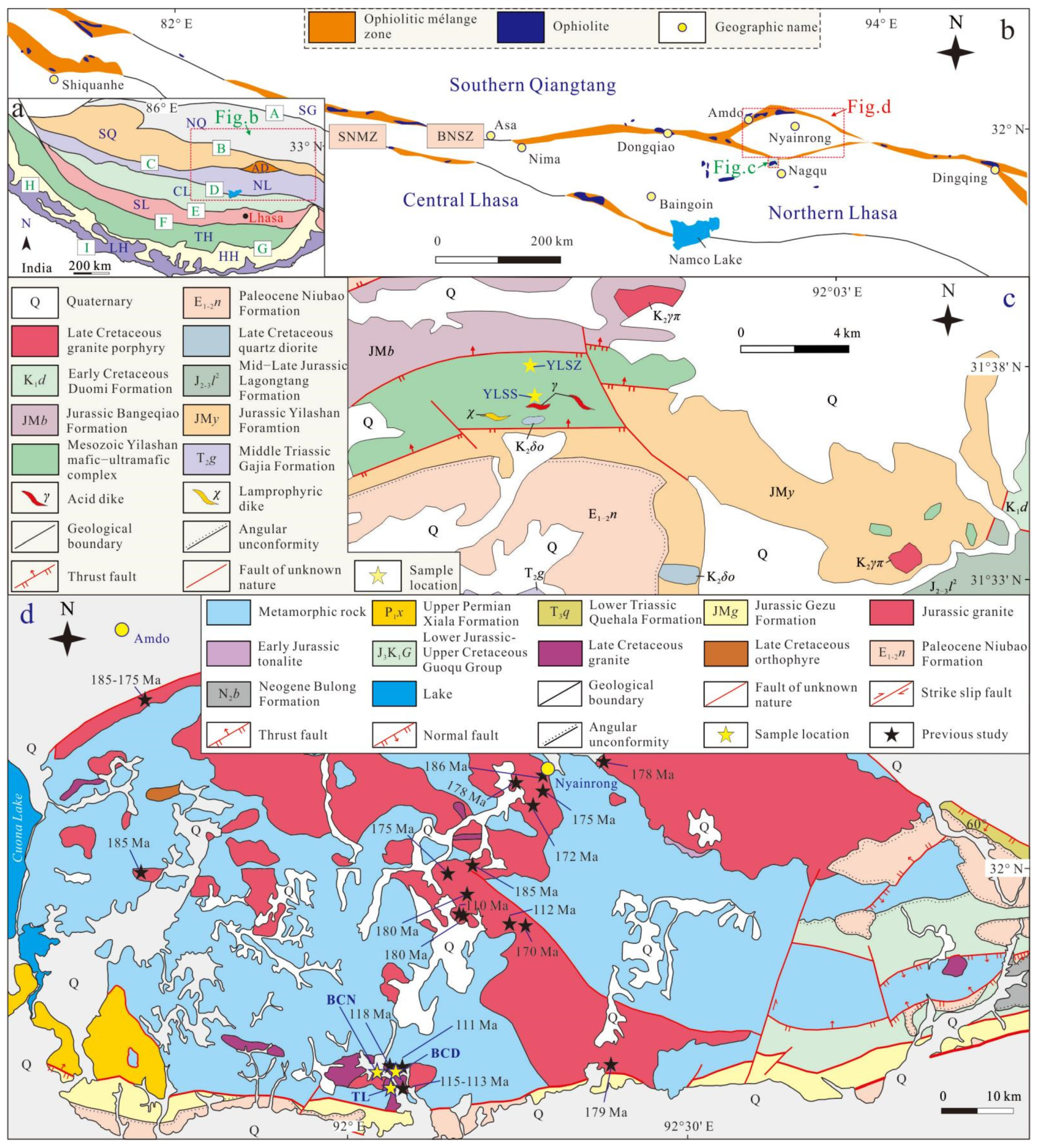
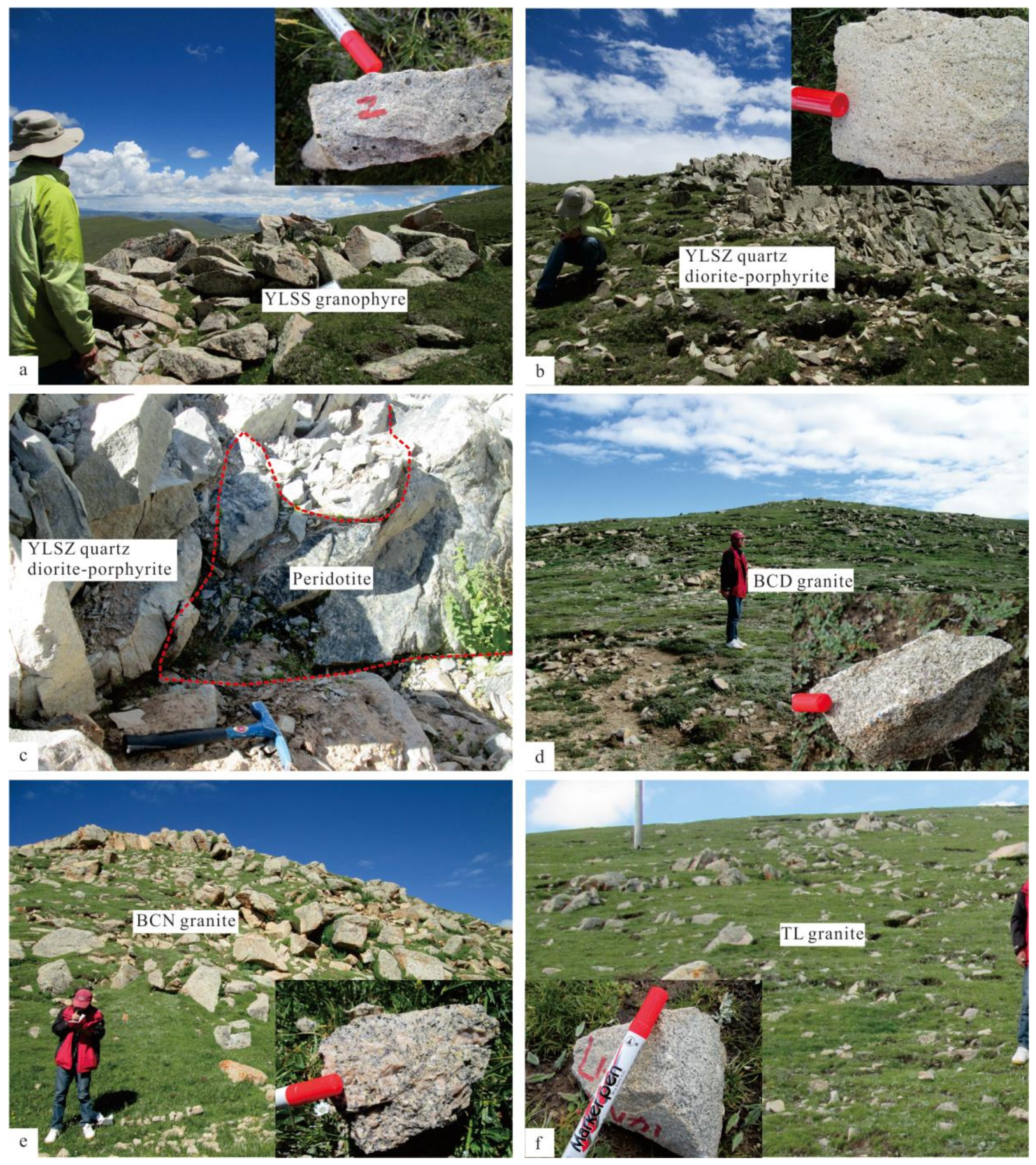

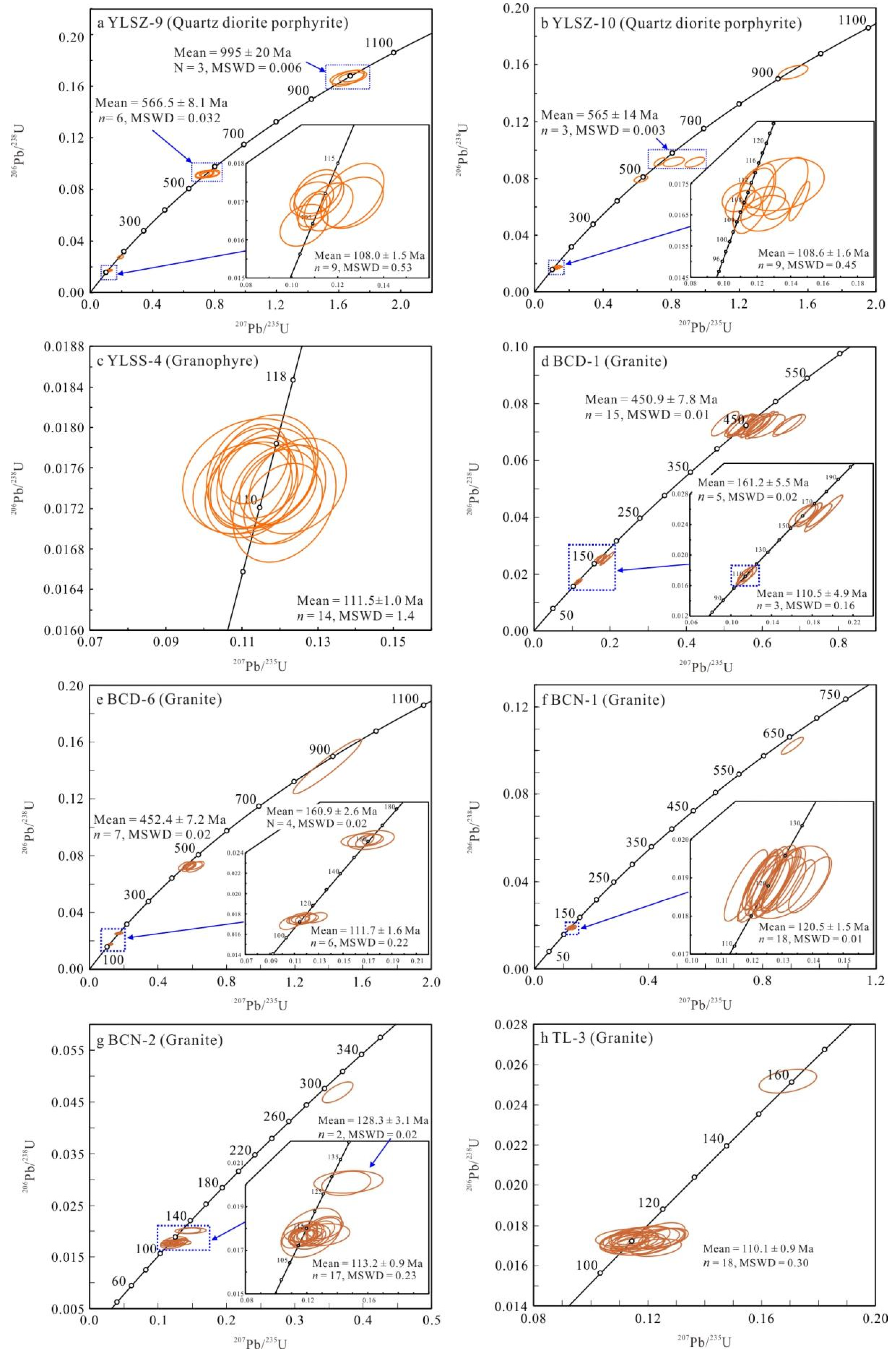
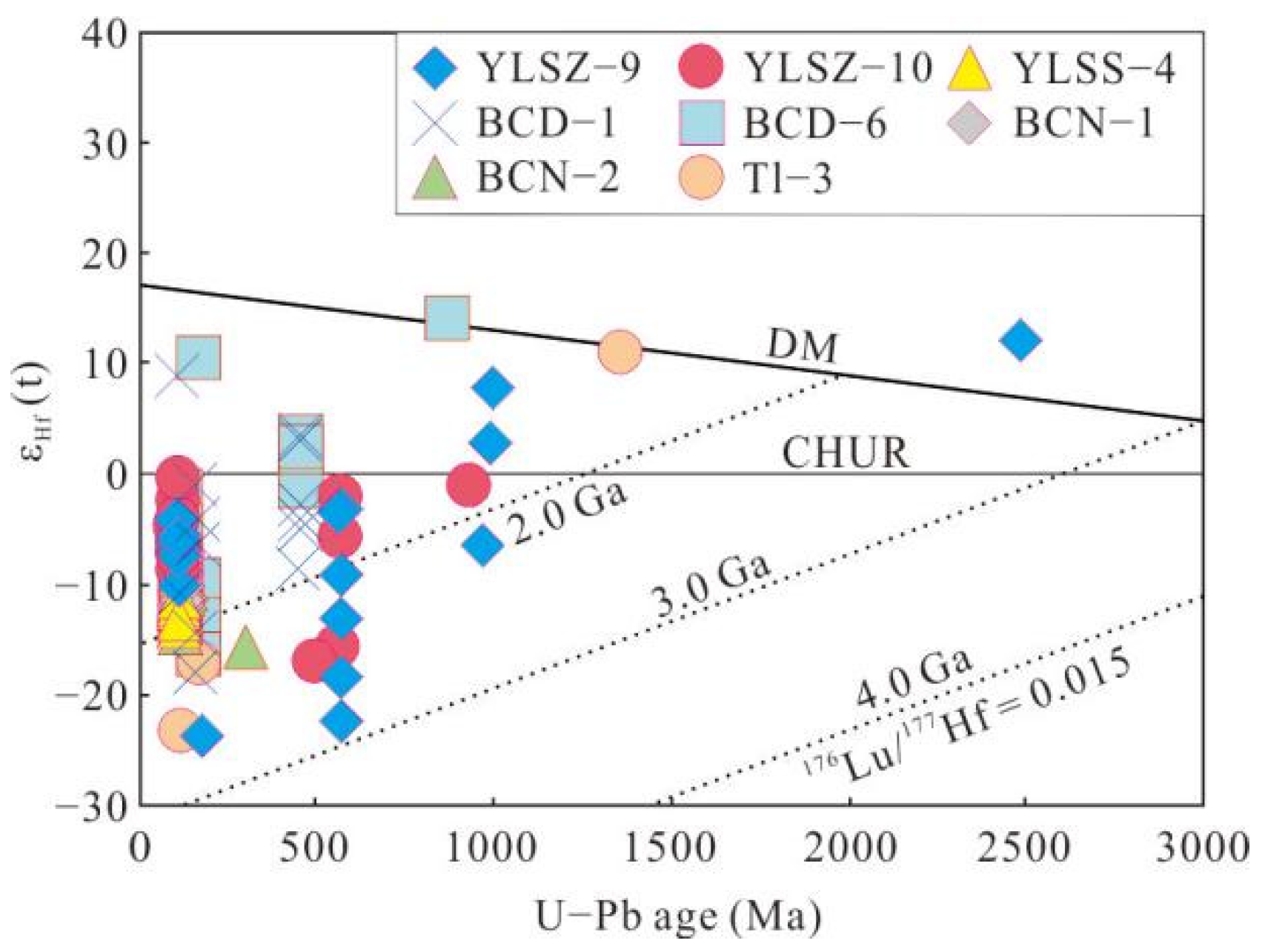
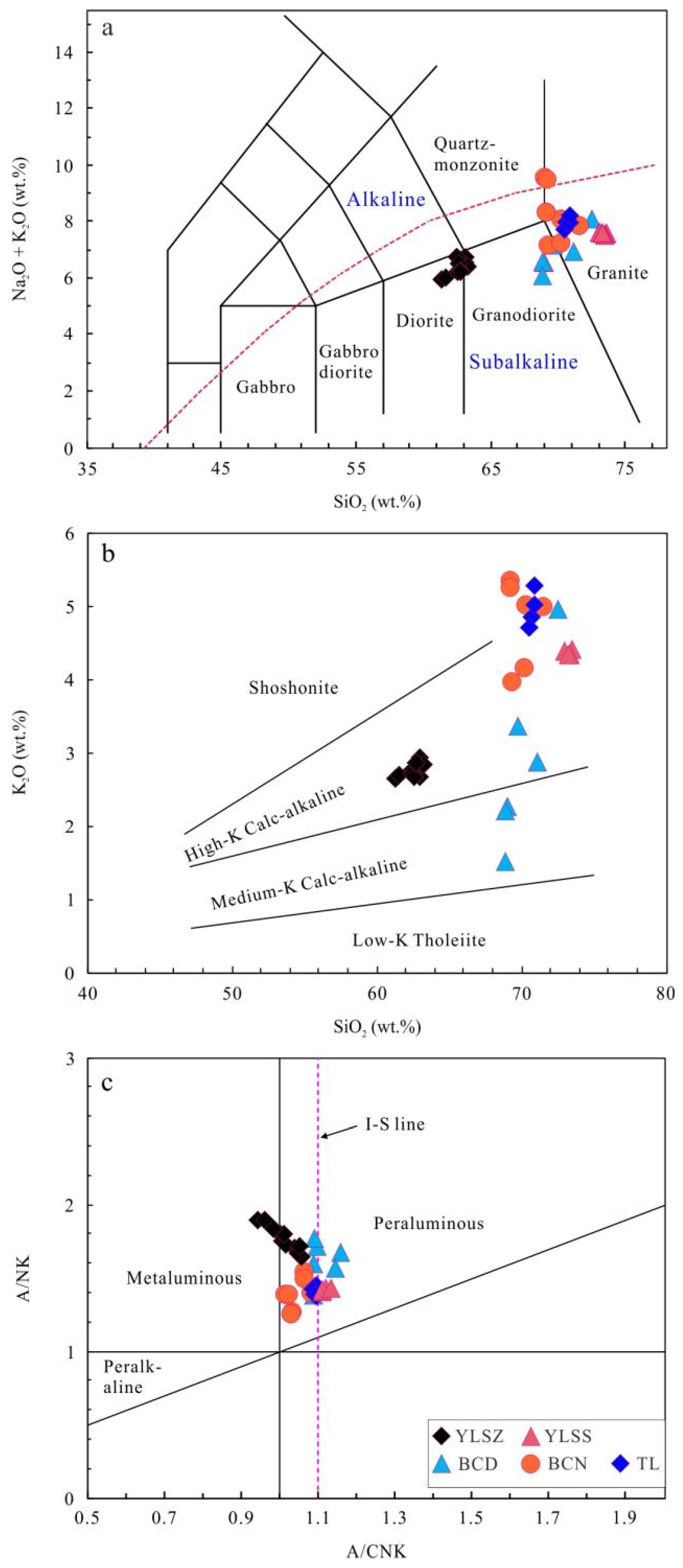
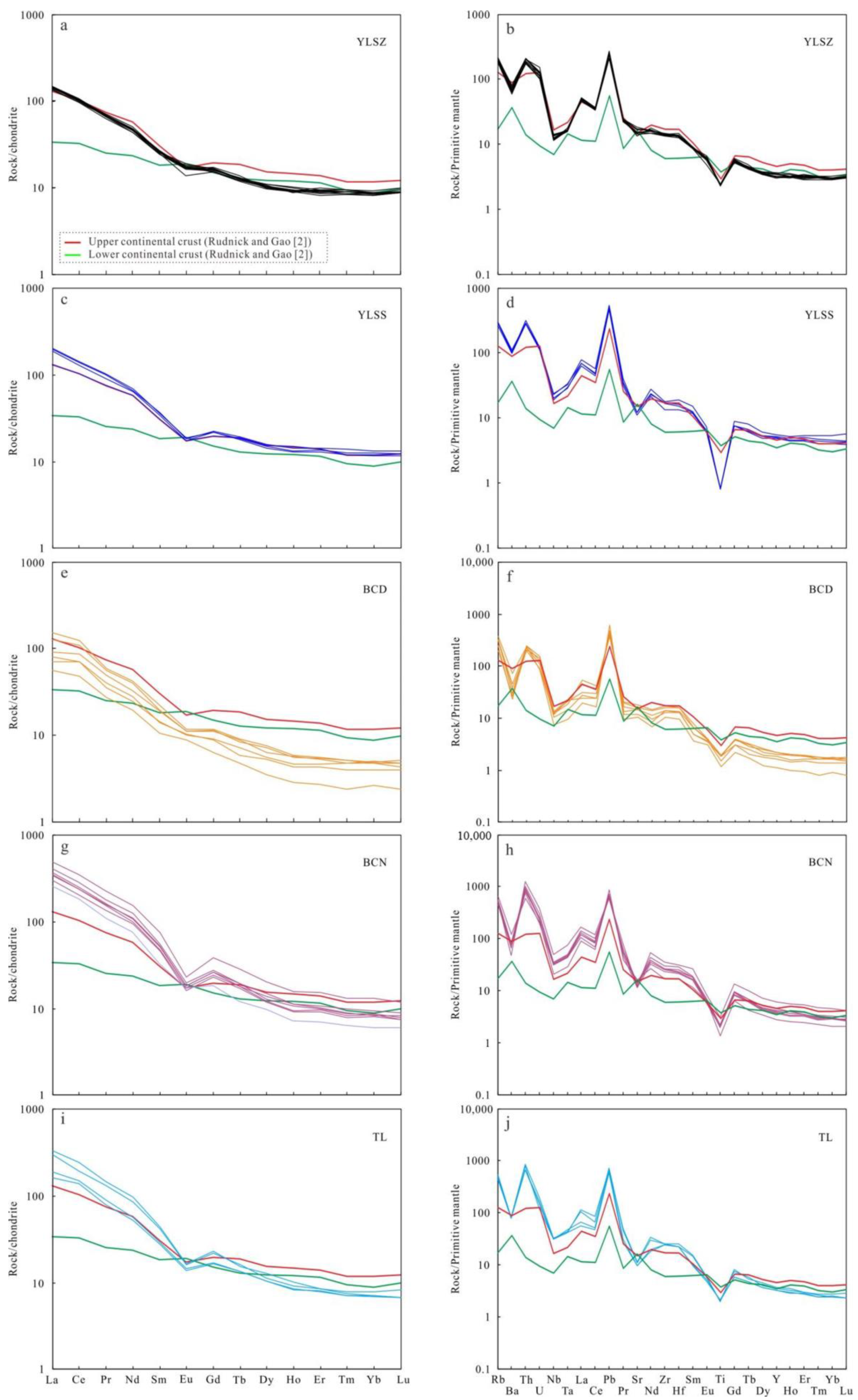
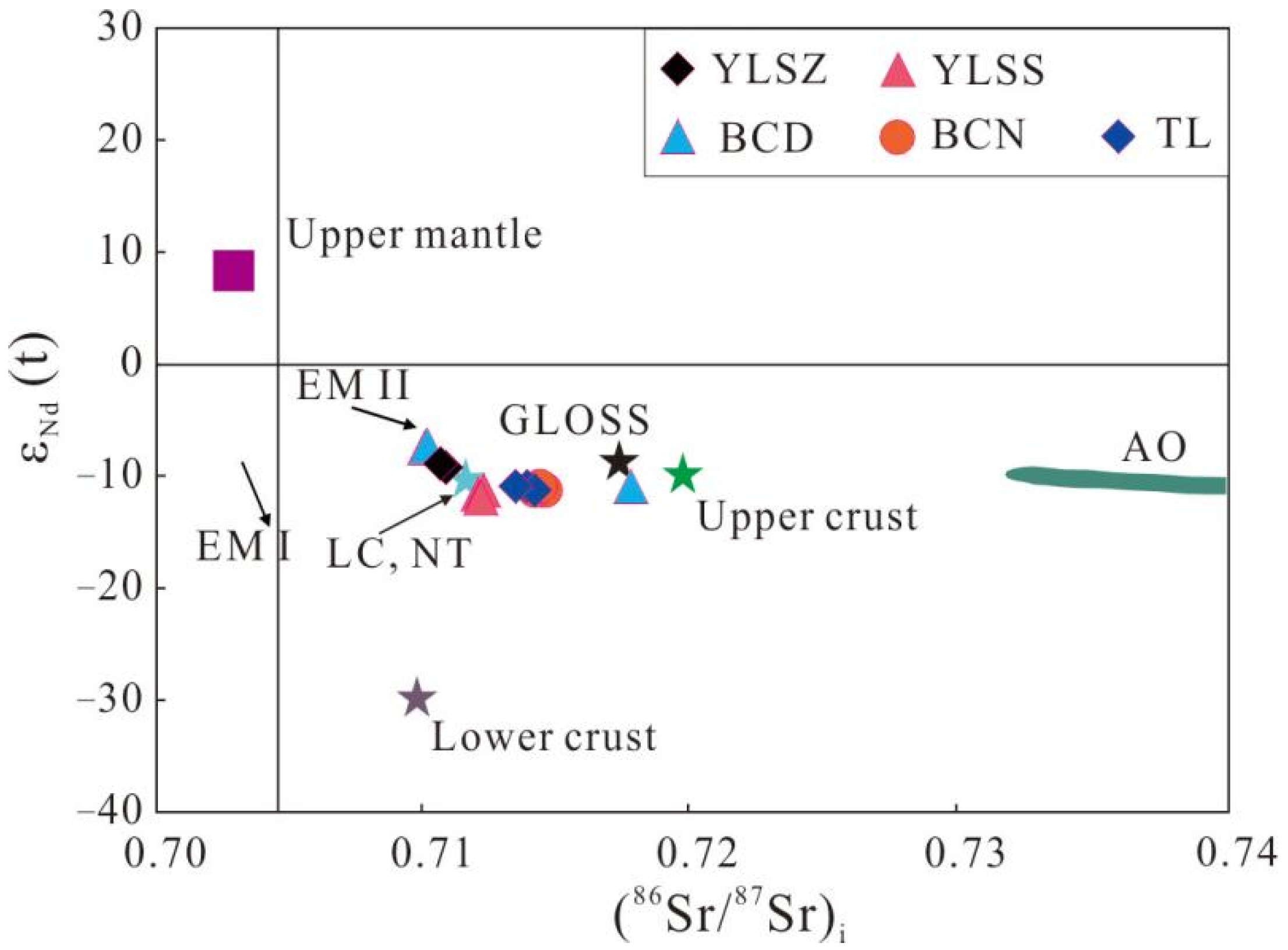

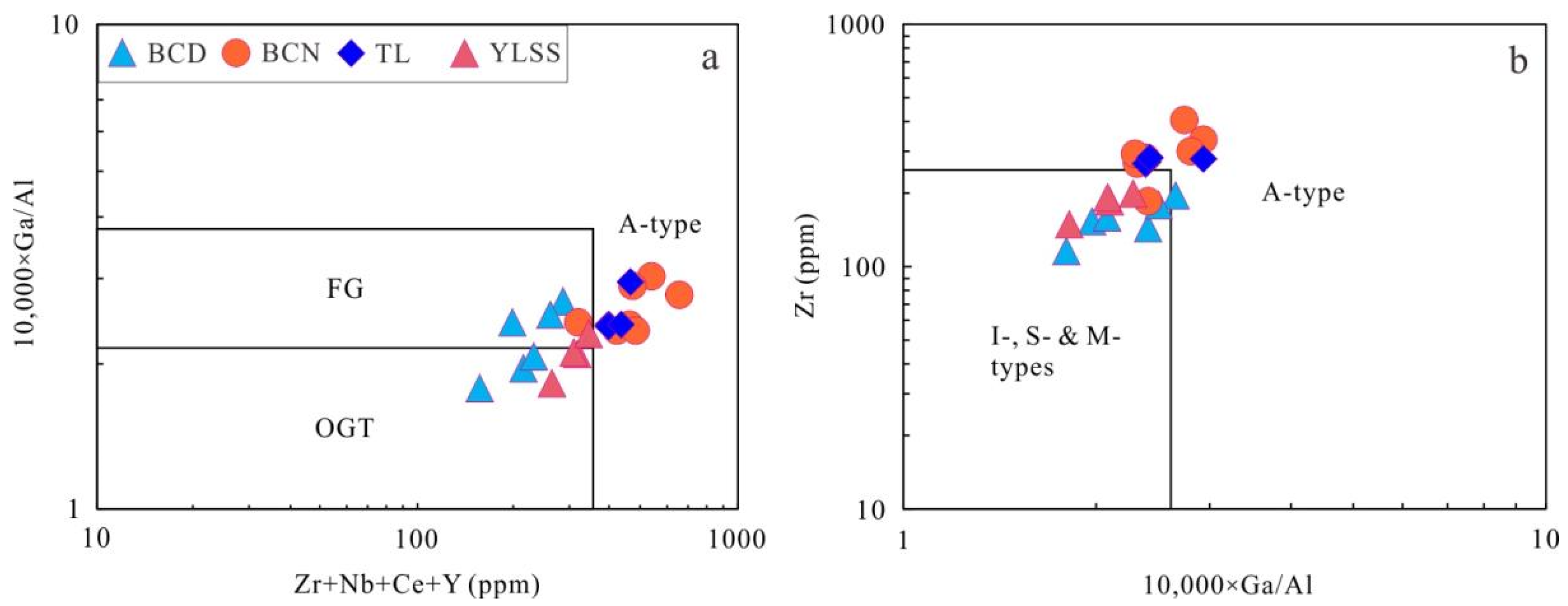


Publisher’s Note: MDPI stays neutral with regard to jurisdictional claims in published maps and institutional affiliations. |
© 2022 by the authors. Licensee MDPI, Basel, Switzerland. This article is an open access article distributed under the terms and conditions of the Creative Commons Attribution (CC BY) license (https://creativecommons.org/licenses/by/4.0/).
Share and Cite
Wu, K.; Zhong, Y.; Yuan, Y.; Wan, Z.; Xia, B.; Wu, T. Early Cretaceous Granitoids Magmatism in the Nagqu Area, Northern Tibet: Constraints on the Timing of the Lhasa–Qiangtang Collision. Minerals 2022, 12, 933. https://doi.org/10.3390/min12080933
Wu K, Zhong Y, Yuan Y, Wan Z, Xia B, Wu T. Early Cretaceous Granitoids Magmatism in the Nagqu Area, Northern Tibet: Constraints on the Timing of the Lhasa–Qiangtang Collision. Minerals. 2022; 12(8):933. https://doi.org/10.3390/min12080933
Chicago/Turabian StyleWu, Kaiyang, Yun Zhong, Yajuan Yuan, Zhifeng Wan, Bin Xia, and Tengfei Wu. 2022. "Early Cretaceous Granitoids Magmatism in the Nagqu Area, Northern Tibet: Constraints on the Timing of the Lhasa–Qiangtang Collision" Minerals 12, no. 8: 933. https://doi.org/10.3390/min12080933
APA StyleWu, K., Zhong, Y., Yuan, Y., Wan, Z., Xia, B., & Wu, T. (2022). Early Cretaceous Granitoids Magmatism in the Nagqu Area, Northern Tibet: Constraints on the Timing of the Lhasa–Qiangtang Collision. Minerals, 12(8), 933. https://doi.org/10.3390/min12080933





